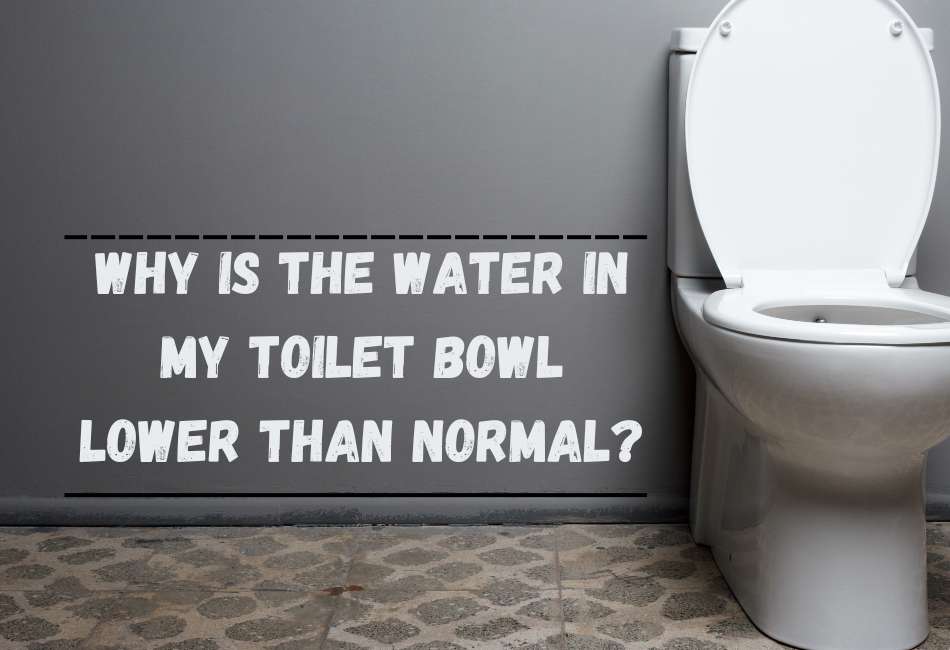The normal water level in a toilet bowl is typically half the bowl’s height, a balance achieved through the interaction of the toilet’s design and plumbing.
Maintaining this water level is significant for efficient toilet operation, ensuring optimal hygiene, and preventing unpleasant odors.
However, there may be occasions when you notice the water level in your toilet bowl decreasing, an issue that various factors can cause.
In this article, we’ll delve into the nine most common reasons why the water in your toilet bowl may be lower than normal, providing you with a comprehensive understanding of these potential plumbing challenges.
Common Causes of Low Water Levels
1. Malfunctioning Float
Think of the float as the overseer of your toilet’s water level. It’s a small ball that floats on top of the water in your toilet tank.
As the water level rises, so does the float, and when it reaches a certain level, it triggers the fill valve to shut off the water.
- How a Malfunctioning Float Can Lead to Lower Water Levels
I remember noticing a decrease in the water level in my toilet bowl. After some sleuthing, I found that the culprit was a malfunctioning float.
When the float is set too low or gets stuck in a low position, it can cause the fill valve to shut off the water prematurely, leading to lower water levels in the bowl.
- Signs of a Faulty Float
In my experience, a constant running water sound from your toilet is a telltale sign of a faulty float. It’s as if the toilet always tries to fill itself up but never quite gets there.
2. Damaged Flapper
The flapper is like the gatekeeper of the water tank. A rubber stopper seals off the tank’s bottom, holding water until the next flush.
- Effects of a Damaged or Worn-Out Flapper on Water Levels
When the flapper is damaged or worn out, it can’t seal the tank properly, causing water to leak into the toilet bowl continuously.
This was an issue I faced in my old apartment – a constantly running toilet due to a worn-out flapper, leading to a lower water level in the toilet bowl.
- DIY Checks for Flapper Issues
If you suspect a flapper issue, here is a DIY tip. Add a few drops of food coloring into the water tank and wait.
If you see the color seeping into the toilet bowl without flushing, you likely have a faulty flapper on your hands.
3. Water Supply Valve Problems
The water supply valve controls the volume of water that enters your toilet tank. It’s essentially the tap that fills the tank after every flush.
- How a Faulty Valve Can Affect Water Levels
I remember when the water supply valve in my toilet went rogue. When this valve fails or is partially closed, it doesn’t let enough water into the tank, leading to a lower water level in the toilet bowl after each flush.
- Steps to Troubleshoot and Fix Valve Issues
If you face a similar issue, ensure the valve is fully open. If that doesn’t solve the problem, it might be time to replace the valve – a fairly simple task with the right tools and patience!
Blockages in the Toilet System
4. Clogged Rim Jets
Rim jets are small holes located under the rim of your toilet bowl. When you flush, water is pushed through these jets, cleaning the bowl’s inner surface and pushing waste into the trapway.
- How Clogs in Rim Jets Contribute to Low Water Levels
A clog in the rim jets can prevent the bowl from filling to its normal level because insufficient water is being pushed into it.
I learned this when a mineral buildup in my toilet’s rim jets caused persistent low water levels.
- Techniques to Clear Rim Jet Blockages
Clearing rim jet blockages can be a messy job, but it’s doable. A simple solution is to use a flexible brush to dislodge the clogs.
Alternatively, you can use a vinegar and baking soda solution, which works wonders to dissolve mineral buildups.
5. Blocked Trapway
The trapway is the channel that connects the toilet bowl to the sewer pipe. All waste and water from the bowl pass through this pathway.
- Effects of a Blocked Trapway on Water Flow
If the trapway is blocked, it can prevent the bowl from filling up with water because the blockage interferes with the normal water flow.
I experienced this problem in my guest bathroom, where a toy left by my nephew caused a blockage.
- Methods for Clearing Trapway Blockages
A plunger often works to clear minor blockages. However, a toilet auger is more effective for stubborn clogs like the one in my guest bathroom.
6. Vent Pipe Obstructions
Vent pipes allow unwanted gases to escape your home’s plumbing system while also ensuring that the pressure in the system is balanced.
- How Obstructions Can Impact Water Levels
If the vent pipe is obstructed, it can cause low water levels in your toilet bowl. I once had a bird nest in my vent pipe, and until I realized what was happening, I couldn’t figure out why the water level in my toilet was consistently low.
- Steps to Identify and Remove Vent Pipe Obstructions
If you suspect a vent pipe obstruction, it’s usually best to call a professional. When I had my issue, a licensed plumber safely removed the bird nest, solving my low water level issue.
Structural Issues and Leaks
7. Cracked Bowl or Tank
Cracks in your toilet bowl or tank can cause serious problems. I once had a hairline fracture in my toilet tank.
At first, it seemed insignificant, but over time the crack expanded, leading to a constant leak and reduced water level in the bowl.
- How Leaks Contribute to Lower Water Levels
Leaks allow water to escape from the tank or bowl, drastically lowering the water level. In my case, the crack in my tank was causing water to continuously seep out, resulting in an irritatingly low water level in the toilet bowl.
- Professional Solutions for Repairing Cracks
When I realized the problem, I called a professional to assess the situation. They sealed the crack effectively, and I haven’t had any leakage issues.
While minor cracks can be fixed with a sealant, significant damage might require replacing the entire bowl or tank.
8. Faulty Wax Ring
The wax ring plays a crucial role in sealing the connection between your toilet and the sewer pipe. I didn’t know about it until I encountered a persistent water leakage issue in my bathroom.
- Signs of a Faulty Wax Ring and Its Impact on Water Levels
One of the signs of a faulty wax ring is a leak around the toilet base. If the ring fails, it can cause a significant decrease in the water level.
I noticed the water level in my toilet bowl was unusually low, and upon investigation, I found out that a faulty wax ring was the culprit.
- Replacing a Wax Ring: A Step-by-Step Guide
Replacing a wax ring seemed daunting at first. However, I managed to do it myself with the right tools and patience.
After removing the toilet, I scraped off the old wax ring, placed the new one on the flange, and reinstalled the toilet.
Remember, it’s always a good idea to call a professional if you’re unsure or uncomfortable performing these steps.
Improper Water Level Adjustment
9. Incorrect Float Adjustment
The float in your toilet tank is a vital component that tells the fill valve when to stop pumping water after each flush.
It took me a while to understand this clever mechanism and its crucial role in maintaining the appropriate water level in your tank and bowl.
- How Incorrect Adjustments Lead to Low Water Levels
When my toilet wasn’t maintaining the right water level, I discovered it was due to an improperly adjusted float.
A float set too low can cause the fill valve to stop pumping water prematurely, resulting in an annoyingly low water level in the bowl.
- Guidelines for Adjusting the Float Correctly
Adjusting the float isn’t as complex as it might seem. The adjustment process will differ depending on the type of float you have (ball float or cylinder float).
You must bend the arm upward to raise the water level for a ball float. For a cylinder float, a small clip usually allows you to adjust the water level. Trial and error helped me find the perfect adjustment for my toilet.
Bonus
10. Inadequate Water Supply
Another reason for low water levels in your toilet could be an inadequate water supply.
The main factors that can impact this include blocked pipes, closed shutoff valves, or city-wide water issues.
I once had a line blockage that significantly reduced my toilet’s water supply.
- Effects of Insufficient Water Supply on Toilet Performance
An insufficient water supply can greatly affect your toilet’s performance, causing lower water levels and weak flushes.
During the aforementioned blockage issue, I noticed that my flushes weren’t as powerful, and the bowl’s water level was consistently low.
- Steps to Ensure an Adequate Water Supply
Ensuring an adequate water supply involves checking your home’s water lines for blockages, ensuring the shutoff valve is fully open, and consulting with your local water department if you suspect a larger issue. I’ve learned to check these aspects regularly to prevent any surprises.
Conclusion
As we’ve seen, the causes of low water levels in your toilet bowl can range from cracks in the tank to improper float adjustment and inadequate water supply, among other reasons.
Addressing these issues promptly is essential, as they can greatly affect your toilet’s performance and overall water usage.
Regular toilet maintenance, including checking for leaks, ensuring a proper water supply, and adjusting the float as necessary, can prevent many of these issues.
Remember, don’t hesitate to call a professional when in doubt – it’s better to be safe than sorry!

